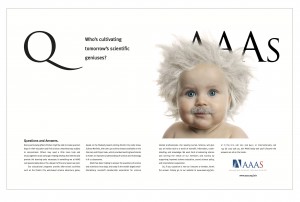At
*UP THERE, EVERYWHERE we have an experienced and international team of people who focus on working with clients in the life sciences – a focus we call
UP* for Life. See the *UP THERE EVERYWHERE website for more details.
In June this year I had the pleasure of taking part in a webinar focusing on the life sciences for the journal
Science. On the panel with me was Hamid Ghanadan of The Linus Group and Bill Moran from Science.
A link to view the webinar can be found here: http://bit.ly/AdWebinar
We had a number of questions come in following our session and some of these are set out below along with the answers.
VIEWER QUESTIONS
It appears that truly successful branding is built on years in the industry. What about brand new businesses in the market with very small staff?
Even big brands had to start somewhere- and normally they started small. The key is to work out what your most important customer touch points are and focus on these. It’s important to get the basics right- what your brand stands for, that everyone in your organization understands your brand and really ‘walks the talk’. Then focus – don’t spread your resources and especially money too thin. Instead do fewer things – but do them really well.
What are the dos and donts for promoting “secondary products” without hurting the brand?
This is always a tricky one and sometimes tempting. Over extension of the brand, and trying to grab more market share, can too often lead you into difficulties. If your secondary product is potentially damaging your primary brand you have to question the rationale for doing it it ends up just confusing people as to what your brand actually stands for and represents. If this is the case you might be better off building a second and separate brand to fit the need. Only if the secondary product can meet a market need in an appropriate way and is on brand overall would I recommend it.
In a digital world, how important is print advertising for a small company with a limited budget to build their brand?
Today digital delivers an amazing capability to build a brand quicker and more cost effectively than ever before. However in building a brand you still need to reach the consumer in a multitude of ways and print advertising still has an important role to play. In working recently with one client we found that digital was the medium that tended to reach our potential audience when they were at work, but that print advertising reached them most effectively when they were relaxing and reading a magazine. It was the combination of the two and especially the print advertising that worked well together.
How do you build brand awareness internally – that is, within a company?
Nothing is more important than the internal audience. If your own people dont get and understand the message your customers never will. We always put a big emphasis on In-Branding before we go external. Typically our programs for this would cascade information down through the organization, with short powerful two way learning sessions. You cant just broadcast the message at people, but you need to find ways to engage them. One recent example saw us running internal competitions through the companys own intranet, that was then followed up with internal brand engagement learning events organized at the companys major sites.
Does any of this take a different flavor when working in the field of education?
I think of all of the areas to work in education can be the most stimulating and powerful few things are more important. Brand building work should always be carried out in an appropriate manner. Its about finding ways to engage with your audience in an appealing but relevant way. When we were helping build awareness of the educational work at AAAS we developed the baby genius image that really caught peoples imaginations – because it was relevant. Having worked for clients in the education area a number of times the danger can sometimes be that ideas can be developed by committees and tend to get watered down. Great brands still need to take a stand and establish a point of view – which might sometimes mean not pleasing everybody.

Baby Genius. Created for the AAAS